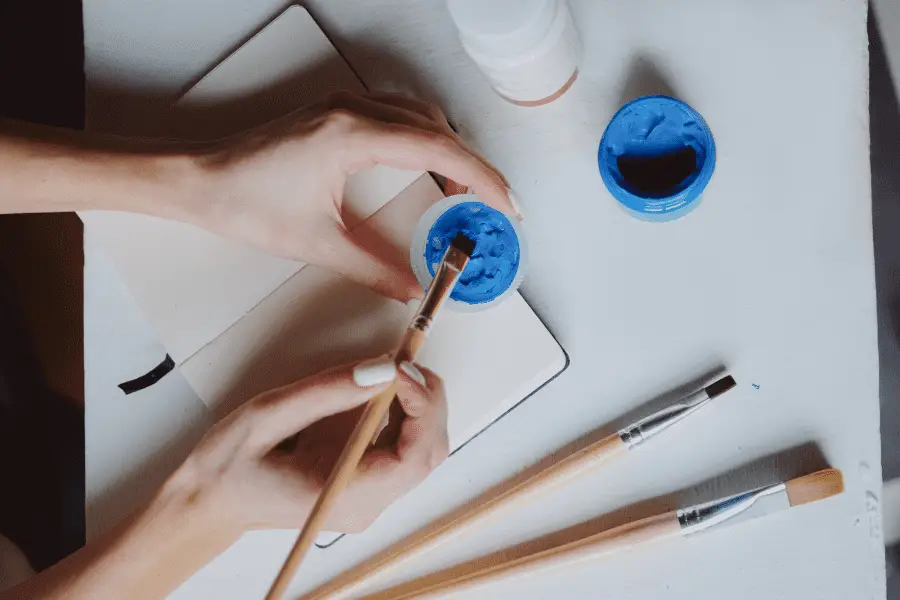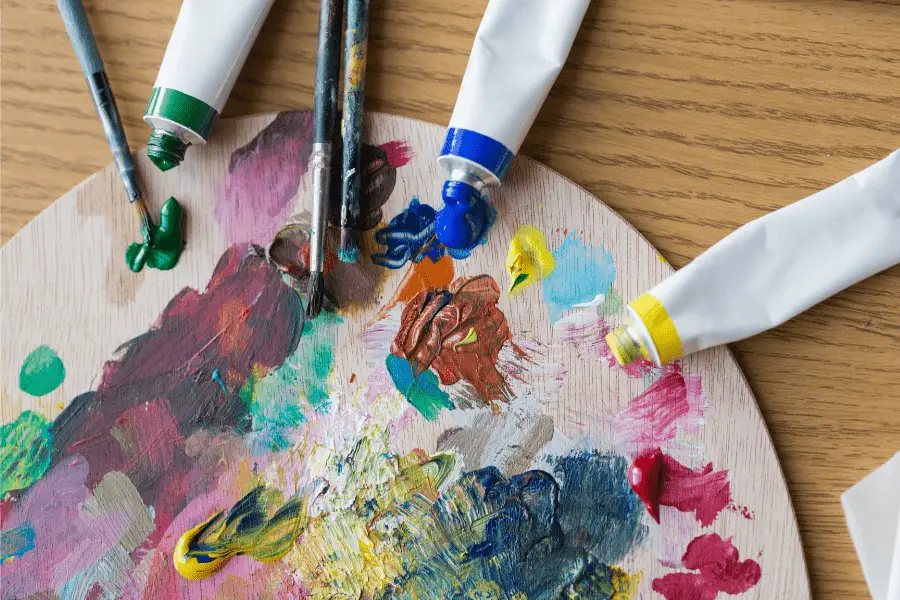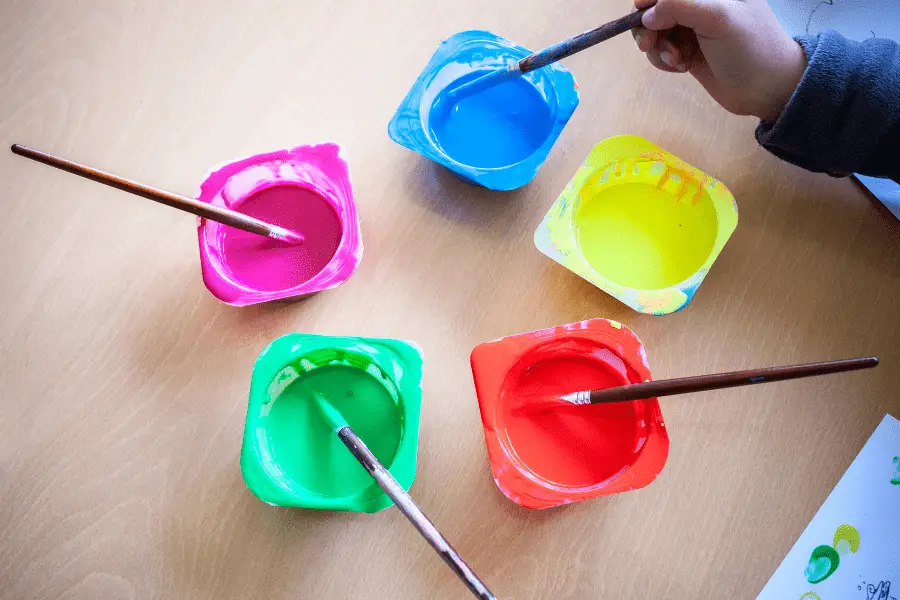If you have an extensive paint collection at home, you might be wondering if you can mix different types of paint. Since tempera paint and acrylic paint are both water-based, many artists think they can combine the two. However, this doesn’t have the effect you’d expect.
So, can you mix tempera and acrylic paint? While you can mix the two, you won’t get a good consistency with your paint. Acrylic paints have a dry glossy finish and are much more permanent than tempera paints. Tempera also has a watercolor-like texture that fades with time. Artists prefer acrylic for expensive, professional projects, while tempera is best for cheaper projects.
Overall, you won’t get the results you want if you mix these two different paints. They have varying ingredients and consistency when they dry. It’s best not to mix them on your palette. Keep reading to learn more!
How To Mix Tempera Paint With Acrylic Paint

If you still want to try mixing your tempera and acrylic paints, you’ll need to do it in a certain way to get better results. You may want to buy dry tempera pigments, then make your own paints. Doing so can help you get the colors that you want.
It’s also important to realize that mixing them will give your paints a grainy texture. Before you get started, you’ll want to think about how your final piece will look its best. Some people enjoy working with a lot of texture, while others don’t.
My favorite and top pick is always Arteza Acrylic Paints. They have so many different colors, and the quality is amazing! I usually use Arteza Paints for all my projects.

First, start by setting some acrylic aside as your base. You can then add some tempera to it until you’ve achieved your desired color. The tempera is thinner and should melt into the acrylic- it would be much harder to use the tempera as a base because of this.
Adding small amounts of tempera at a time is best. That way, you can easily test your paint on a blank sheet before moving on to the final piece. You’ll want to wait for the test project to dry since tempera can become chalky and flake off. If that happens, you’ll want to remix the paint in different ratios.
You can also use tempera and acrylic paints on the same canvas without mixing them. Since tempera colors are cheaper and thinner, they tend to dry a lot lighter. Many artists paint with tempera, wait for it to dry, then go over it with their acrylic paints. This process is similar to sketching out your painting first.
Overall, you’ll want to take your time and have patience when you mix these two mediums. You can experiment and remix the paint if you don’t find a texture you like right away.
What’s the Difference With Acrylic Paint and Tempera Paint?

There are a few significant differences between these two types of paint. After drying, acrylic is permanent and dries into a plastic-like skin. Tempera is semi-permanent and still water-soluble after drying. That means you can add water and continue working with tempera.
Tempera paints always dry in a matte, opaque form. If you were to touch a tempera painting, it might even feel a bit chalky or dusty to you. These differences make tempera more suitable for inexpensive projects.
Each type of paint has circumstances where it works best. For example, teachers prefer tempera for making crafts with their students. The color is easy to clean and wash off in the sink, unlike acrylics.

Many people that enjoy customizing clothing and accessories also use acrylics. Since this type of paint is more permanent, they won’t need to worry about it flaking off.
In short, all of these differences come from the materials used to prepare the paints. While both contain water, tempera tends to contain more natural ingredients, such as egg proteins. Organic materials do break down faster, so this paint tends to have the lower shelf life of the two.
What Is Ready Mix Tempera Paint?

Ready-mix tempera paints tend to suit young kids the best. They’re already prepared and easy to use straight out of the bottle. You won’t need to use pigments or powders when using ready-mix paints! However, you can always use them if you don’t want to mix your own pigments.
That said, ready mix tempera is perfect for any age. You can use these paints to build your painting skills before moving on to using other materials. The paint is usually thin, making it easier to spread and work with. Suppose you want a thicker layer of color. In that case, you’ll need to apply another coating after waiting for it to dry completely.

Finally, ready mix tempera tends to work the best on paper, cloth, wood, canvas, and cardboard. These materials are porous and can easily absorb color. However, you can always experiment with different surfaces!
Can Tempera Paint Be Used As Finger Paint?

Tempera paint is perfect for finger painting! The paint is non-toxic and easy to use with water. Plus, it’s also easy to clean off your hands afterward.
Everyone can benefit from finger painting- it enhances fine motor skills and is a fun way to express yourself! Tempera is easy to apply using fingers but also can be applied using other objects. For instance, you can use stamps and even sponges to add unique designs and textures to the painting!
My kids use either Arteza Tempera Paints, or Crayola for their projects. Arteza does tend to have more options for tempera paint, as in colors, styles, and even kits.

In short, many people often choose tempera paint for finger painting. If you use acrylic, you could end up with a huge mess! Acrylic can also clog the sink when you wash it off, making tempera the better option.
How Do You Seal Tempera Paint

After creating a tempera painting, it’s a good idea to seal it. If you don’t, you could easily lose all your hard work! You’ll want to use an acrylic (or water-based) sealant. You can find spray-on and paint-on varieties.
I always recommend using Krylon Sprays. They work great for tempera paint, acrylic, and even gouache. Krylon also protects your paint form chipping, flaking, and even UV rays!
Before sealing the painting, make sure you allow it more than enough time to dry. If you attempt to seal wet paint, the colors are sure to smear or run. Always apply the sealants in thin layers, then add another layer after that dries. You may also only need one layer if you aren’t planning on putting the painting outside.
When applying a spray-on sealant, hold the can at least six inches away from the piece. That way, you won’t accidentally spray away the tempera! For paint-on variants, use a larger brush dipped in small amounts of sealant. You don’t want to apply too much at once, or you could warp the page.

Overall, adding a seal to tempera paint makes it permanent and waterproof. You won’t have to worry about the colors flaking or washing away.
Final Thoughts
To summarize, while you can mix these paints, you probably won’t want to! Acrylic and tempera paints use different ingredients, even though they’re both water-based materials. If you do mix them, you won’t get the consistency you want with your color.
However, you shouldn’t let that stop you from experimenting with your art! You can always use these pants together on a piece, although I wouldn’t recommend that you mix them on your palettes. Tempera colors do tend to fade much faster than acrylics and have a matte appearance.
Make sure to follow all my tips and recommended products to ensure your tempera or acrylic paint project turns out great! Also, don’t forget to check out my other articles for all your painting Q&A’s. Happy painting!

